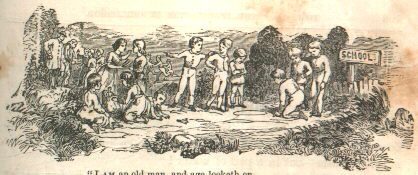“Join in the Recreation of Your Children,” by S[tephen] T. A[llen] (from The Mother’s Magazine and Family Journal, July 1851; pp. 197)

“I am an old man, and age looketh on,
To the time that shall be—from the time that is gone;
But you, blessed creatures! you think not of sorrow,
Your joy is to-day—and ye have no to-morrow!
Aye; sport ye—and wrestle—be glad as the sun,
And lie down to rest when your pastime is done,
For your dreams are of sunshine, of blossoms and dew,
And the God of the blessed doth watch over you,
And an old man’s blessing doth on you dwell
The whole day long—and so fare ye well.”
JOIN IN THE RECREATIONS OF YOUR CHILDREN.
In this beautiful group there is an epitome of the sports and pleasures of childhood. As we look upon it our heart warms with glowing remembrances of the time when we were young as they. On the right are the boys—one with a bat-stick, another with a hoop-stick, as if they were just resting from active sports. In the foreground are the girls, with their doll in its tiny chair, while farther back, two are engaged in a spirited conversation. In the rear is the eager chase, while at the extreme left is a group engaged with two old men, who, for aught we know, may be Peter Parley and Robert Merry. None would enjoy such scenes better than they.
The point in the picture which to us is most interesting, is this:—Age and childhood meet and mingle their pleasures. It is said that youth lives in the future—age in the retrospect. While this is essentially true, there is much common ground on which their sympathies can unite; and it were well for both if it were more occupied. By such communion, age revives the freshness and buoyancy of youthful feeling, while youth learns to look on life with a more sober estimate.
Parents who enter into the sympathies of childhood and form its merry pastime, will not dampen, but increase its pleasures. Go then with your children on the Fourth of July and on other holiday occasions. Enter with a hearty interest into their youthful pleasures—adapt their recreations so as to secure the best objects. While you fall in with—at the same time guide the youthful taste. You will benefit your own feelings, and at the same time acquire an ascendency over their which nothing else will furnish.
S. T. A.